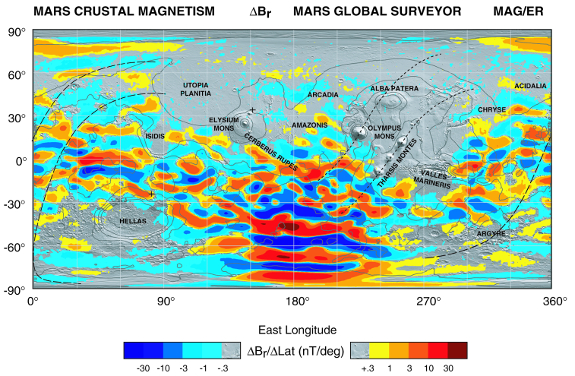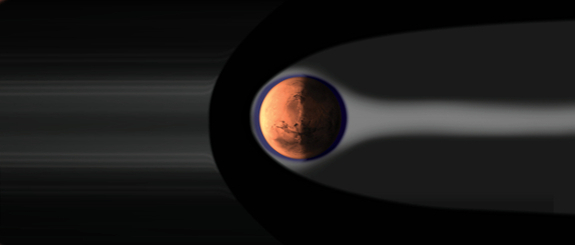Mars' ionosphere shaped by crustal magnetic fields
3 November 2016
Scattered pockets of magnetism across the surface of Mars have a significant influence on the planet's upper atmosphere, according to observations from ESA's Mars Express. Understanding these effects may be crucial for ensuring safe radio communications between Mars and Earth and, eventually, between explorers on the surface of the planet.Earth's magnetic field is dominated by a single, strong source: the dynamo deep below the planet's surface. However, the same cannot be said for Mars. Rather than possessing a single source of magnetic field, Mars has many.
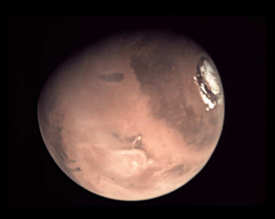 |
| Mars as viewed by the Visual Monitoring Camera on Mars Express. Credit: ESA/D. O'Donnell - CC BY-SA IGO |
The Red Planet has numerous pockets of strong magnetism locked up within its crust, remnants from its earliest days. Modern-day Mars may be known for its relative lack of magnetism but young Mars was likely a different world; it was probably warmer and wetter, with a denser atmosphere and a hotter core. Scientists believe the young planet also had a sizeable magnetic field, driven by the circulating motion of molten material within its core (known as a planetary dynamo).
This global field switched off long ago – likely as the core cooled and solidified, freezing the dynamo in place – but the planet still boasts anomalous patches of strong remnant magnetism spread across its surface, known as 'crustal fields'.
Magnetic memories of early Mars
Parts of Mars' crust and rock remain magnetised today due to a phenomenon known as 'ferro-magnetism', which lasts even when the external magnetic field is no longer present (as is the case with Mars).
Mars' crust cooled to below a specific temperature – known as the Curie temperature [1] – when the planet's core dynamo, and thus its magnetic field, was still active and present, causing residual magnetism to become permanently locked within ferrous (iron-containing) material in the crust. Similar crustal magnetic fields are also found on the Earth and the Moon.
These fields can later be removed by reheating material to above the Curie temperature – via large impacts, for example – and then allowing it to cool again in the absence of a magnetic field.
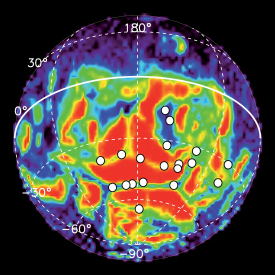 |
| Mars Express aurora detections. Credit: Based on data from J.-C. Gérard et al. (2015) |
Magnetism is thought to have been wiped out from sizeable patches of the martian crust in this way, but large portions of the southern, and smaller parts of the northern, hemisphere of Mars remain magnetised to some degree, with pockets scattered planet-wide. These crustal fields are strong enough to drive features in Mars' upper atmosphere akin to the aurorae seen on Earth – such features have been seen by ESA's Mars Express).
"They may be weak in terms of absolute strength – hundreds of nanotesla in the upper atmosphere on average, or between 0.1 and 1 per cent of the field strength produced by the Earth's dynamo at the equivalent altitude – but Mars' crustal fields are significantly stronger than those found on the Earth or the Moon," says Markus Fraenz of the Max Planck Institute for Solar System Research in Göttingen, Germany. "This indicates that Mars' dynamo field was once at least as strong as Earth's – but in order to produce such strong patches of remnant crustal magnetisation, it was probably stronger than our planet's has ever been."
Unfortunately no lander or rover has yet reached these sites of strong magnetisation, but comprehensive observations from long-lived orbiters such as NASA's Mars Global Surveyor and ESA's Mars Express have helped scientists to characterise Mars' magnetic environment.
Mars Express has been in orbit around Mars since 2003, and has completed numerous studies using its MARSIS (Mars Advanced Radar for Subsurface and Ionosphere Sounding) and ASPERA-3 (Analyzer of Space Plasmas and Energetic Atoms) instruments to explore the effect these crustal fields have on Mars' ionosphere.
"Mars' crustal fields appear to strongly control the plasma in the planet's upper atmosphere," says David Andrews of the Swedish Institute of Space Physics in Uppsala. More specifically, they affect a layer of weakly ionised gas known as the ionosphere, which sits sandwiched between the bulk of Mars' neutral atmosphere and the intense radiation of outer space (including the solar wind, a stream of charged particles – protons and electrons – emanating from the Sun).
Climbing plasma in Mars' ionosphere
Mars' ionosphere is quite similar to Earth's in many respects, such as the typical densities, altitudes, and so on. "Earth's ionosphere is a bit more complex in terms of its structure, and has a larger number of distinct layers," says Andrews. "This is partly due to Earth's atmosphere being a mix of nitrogen and oxygen, unlike the CO2-dominated martian atmosphere."
Mars' crustal fields affect the motion and dynamics of its ionospheric plasma, influencing how it circulates, accumulates, and escapes to space. For example, plasma soars to far higher altitudes than expected in regions with vertically-oriented crustal fields, and areas with stronger crustal fields are topped by denser and more extensive layers of ionosphere than weaker or absent fields.
Mars' ionosphere sits at the boundary between Mars' lower atmosphere and the solar wind, which floods out into space from the Sun. The solar wind also drags the solar magnetic field out into the Solar System as it travels, creating the interplanetary magnetic field (IMF).
When dragged into Mars' vicinity, IMF field lines can connect with the field lines emanating from some regions of Mars' crust (a process known as 'magnetic reconnection'). This process allows plasma to race upwards along the newly-created lines and escape to space, creating narrow cavities within Mars' ionosphere that are comparatively lacking in electrons.
"The big question, however, is whether or not these crustal fields affect the rate at which Mars loses its atmosphere to space and if so, how," says Andrews. "It's likely that while plasma is reconfigured in regions where the field is strong, the long-term averages of atmospheric escape are not massively different – but we're unsure."
From day to night
The behaviour and properties of the ionosphere differ between the region nearest the Sun (the 'dayside', between Mars and the Sun) and that stretching away from it (the 'night side', tailing away from Mars towards the outer Solar System).
Mars Express data have shown the dayside ionosphere to be surprisingly complex and variable, with electron densities and structured layers of plasma that change abruptly and inconsistently. The satellite has also flagged up how much there is to understand about the night side, and why some of its properties differ considerably from the dayside.
The process of plasma escape via magnetic reconnection, for example, is especially efficient at the day-night boundary (the regions surrounding this boundary, or terminator, are sometimes named 'morning' and 'evening' or 'dawn' and 'dusk'). Similarly, the ionosphere on the dayside is both denser and stretches to higher altitudes over crustal anomalies than on the night side. Plasma also appears to flow towards Mars on the dayside, and away at the day-night boundary.
In general, the number and density of electrons in the ionosphere increases with field strength during the day and at the boundary between day and night – but on the night side, the opposite is true. Mars' night side ionosphere is patchy; it is replenished by some of the plasma from the dayside ionosphere, and by precipitating electrons from the solar wind and magnetosphere (the region of space over which Mars' small intrinsic magnetic field dominates).
"This all reinforces the idea that Mars' plasma environment is strongly influenced by both the levels of incoming solar radiation, and the strength and distribution of the planet's crustal fields," says Eduard Dubinin of the Max Planck Institute for Solar System Research in Göttingen, Germany. "We need to understand much more about these interactions and about Mars' ionosphere in general to paint a detailed picture of Mars' longer-term evolution in terms of climate, habitability, loss of water and atmosphere, and more."
Issues for Red Planet radio?
As well as forming a better scientific understanding of Mars as a planet, knowing more about the martian ionosphere and crustal fields is vital for missions currently at Mars, and for those planned in the future (including crewed missions).
For example, the ionosphere dictates how, when, and where Mars Express' radar equipment (MARSIS) can operate. The dayside ionosphere of Mars is denser and more reflective of radio waves. MARSIS can thus probe Mars' ionosphere on the dayside, as the plasma there reflects incoming radar pulses at the appropriate frequencies (~MHz). On the night side, however, MARSIS performs subsurface sounding. The instrument's radio waves reach through the comparatively sparse ionosphere and can make it far further before being reflected, reaching Mars' surface and up to about 10 km below.
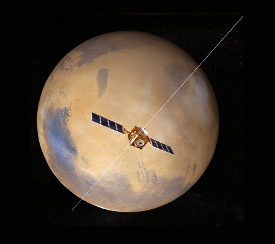 |
| Mars Express with MARSIS antenna unfurled. Credit: ESA |
"MARSIS can exploit the varying properties of the ionosphere, making it a great instrument to probe both the ionosphere and subsurface of Mars," says Dmitri Titov, project scientist for ESA's Mars Express.
The variability of the martian ionosphere could be an issue, however, for any communications on the surface of Mars.
Landers and rovers on Mars communicate with Earth via an orbiter, which in turn uses high enough radio frequencies (GHz) that the ionosphere is not a huge obstacle. However, this may become a larger issue if and when humans set foot on the planet.
"Shortwave radio communications (MHz) on the surface may be affected by variability of Mars' ionosphere, especially around stronger crustal fields, and our understanding here is still incomplete," adds Titov. "Understanding more about Mars' magnetic and plasma environment is key. Findings such as these from Mars Express are crucial to our continued exploration of the Solar System, whether with robots or human crews."
Background Information
[1] The Curie temperature is the temperature above which some materials lose their permanent magnetic properties.
Contributing studies include:
Martian ionosphere observed by Mars Express. 1. Influence of the crustal magnetic fields, by E. Dubinin et al., Planetary and Space Science, Vol. 124, May 2016, pp.62-75; doi: 10.1016/j.pss.2016.02.004
Empirical model of the Martian dayside ionosphere: Effects of crustal magnetic fields and solar ionizing flux at higher altitudes, by F. Nemec et al., Journal of Geophysical Research: Space Physics, Vol. 121, February 2016, pp. 1760-1771; doi: 10.1002/2015JA022060
The morphology of the topside ionosphere of Mars under different solar wind conditions: Results of a multi-instrument observing campaign by Mars Express in 2010, by P. Withers et al., Planetary and Space Science, Vol. 120, January 2016, pp. 24-34; doi: 10.1016/j.pss.2015.10.013
Control of the topside Martian ionosphere by crustal magnetic fields, by D. Andrews et. al., Journal of Geophysical Research: Space Physics, Vol. 120, April 2015, pp. 3042-3058; doi: 10.1002/2014JA020703
The measurements were conducted by the Mars Express Analyzer for Space Plasmas and Energetic Atoms (ASPERA-3) plasma instrument suite and the Mars Advanced Radar for Sub-Surface and Ionospheric Sounding (MARSIS).
For further information, please contact:
David Andrews
Swedish Institute of Space Physics
Sweden
Phone: +46 (0) 184715922
Email: david.andrews![]() irfu.se
irfu.se
Eduard Dubinin
Max Planck Institute for Solar System Research
Göttingen, Germany
Phone: +49 551384979-129
Email: dubinin![]() mps.mpg.de
mps.mpg.de
Markus Fraenz
Max Planck Institute for Solar System Research
Göttingen, Germany
Phone: +49 551384979-441
Email: fraenz![]() mps.mpg.de
mps.mpg.de
Dmitri Titov
ESA Mars Express project scientist
Directorate of Science
European Space Agency
Email: dmitri.titov![]() esa.int
esa.int

